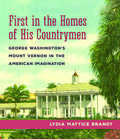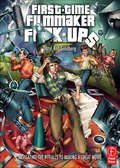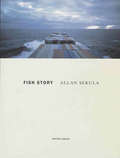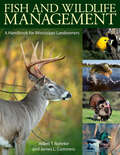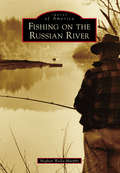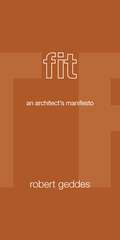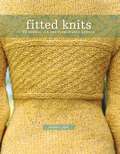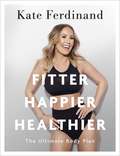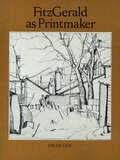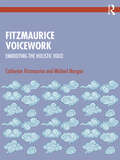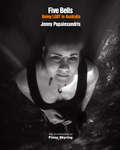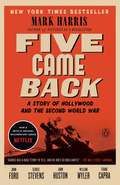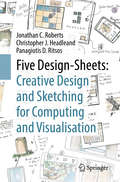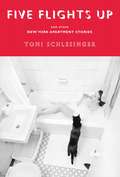- Table View
- List View
First World War Uniforms: Lives, Logistics, and Legacy in British Army Uniform Production, 1914–1918 (Modern Conflict Archaeology)
by Catherine Price-RoweView any image of a Tommy and his uniform becomes an assumed item, few would consider where and how that uniform was made. Over 5 million men served on the Western Front, they all required clothing. From August 1914 to March 1919, across all theaters of operations, over 28 million pairs of trousers and c.360 million yards of various cloth was manufactured.Worn by men of all ranks the uniform created an identity for the fighting forces, distinguished friend from foe, gave the enlisted man respect, a sense of unity whilst at the same time stripping away his identity, turning a civilian into a soldier. Men lived, worked, slept, fought and died in their uniform.Using the authors great-grandfather's war service as a backdrop, this book will uncover the textile industries and home front call to arms, the supply chain, salvage and repair workshops in France, and how soldiers maintained their uniform on the front line.Items of a soldiers uniform can become a way to remember and are often cherished by families, creating a tangible physical link with the past, but the durability of cloth to withstand time can create an important legacy. The fallen are still discovered today and remnants of uniform can help to identify them, at the very least the color of cloth or type of hob nail can give the individual his nationality allowing them to be given a final resting place.
First in the Homes of His Countrymen: George Washington's Mount Vernon in the American Imagination
by Lydia Mattice BrandtOver the past two hundred years, Americans have reproduced George Washington's Mount Vernon plantation house more often, and in a greater variety of media, than any of their country's other historic buildings. In this highly original new book, Lydia Mattice Brandt chronicles America's obsession with the first president's iconic home through advertising, prints, paintings, popular literature, and the full-scale replication of its architecture.Even before Washington's death in 1799, his house was an important symbol for the new nation. His countrymen used it to idealize the past as well as to evoke contemporary--and even divisive--political and social ideals. In the wake of the mid-nineteenth century's revival craze, Mount Vernon became an obvious choice for architects and patrons looking to reference the past through buildings in residential neighborhoods, at world's fairs, and along the commercial strip. The singularity of the building's trademark piazza and its connection to Washington made it immediately recognizable and easy to replicate. As a myriad of Americans imitated the building's architecture, the Mount Vernon Ladies' Association carefully interpreted and preserved its fabric. Purchasing the house in 1859 amid intense scrutiny, the organization safeguarded Washington's home and ensured its accessibility as the nation's leading historic house museum. Tension between popular images of Mount Vernon and the organization's "official" narrative for the house over the past 150 years demonstrates the close and ever-shifting relationship between historic preservation and popular architecture.In existence for roughly as long as the United States itself, Mount Vernon's image has remained strikingly relevant to many competing conceptions of our country's historical and architectural identity.
First-Person America
by Ann BanksBetween 1938 and 1942 the Federal Writers' Project set out to create a first-person portrait of America by sending young writers--many of whom later became famous--around the country to interview people from all occupations and backgrounds. This book presents 80 of these diverse life histories, including the stories of a North Carolina patent-medicine pitchman, a retired Oregon prospector, a Bahamian midwife from Florida, a Key West smuggler, recent immigrants to New York, and Chicago jazz musicians. Historian Eric Foner called First-Person America "the finest example yet of an increasingly important genre of oral history."
First-Time Filmmaker F*ck-ups: The Common Mistakes New Filmmakers Make, and How to Avoid Them
by Daryl GoldbergLearn to avoid the costly mistakes that commonly plague independent filmmakers with this concise and informative how-to guide. Laced with examples from famous movies, directors, and producers, author Daryl Bob Goldberg empowers you with the practical knowledge to achieve a dream that is not as intimidating as you might think This book will help you avoid problems associated with fund-raising, budgeting, scheduling, casting, shooting, actors, crew, postproduction, distribution, legal issues, and much more, all written by someone who has learned these lessons the hard way-so you don't have to.
Fish Story
by Allan SekulaInitially published in print in collaboration with Richter Verlag, Dusseldorf and the Fotografiska Museet in Moderna Museet, Stockholm; Tramway, Glasgow; Le Channel, Scène nationale and Musée des Beaux Arts et de la Dentelle, CalaisTexts by: Allan Sekula, "Fish Story," "Dismal Science" Benjamin H.D. Buchloh, "Allan Sekula: Photography between Discourse and Document"With the exhibition Fish Story, American artist Allan Sekula (1951) reconstructed a realist model of photographic representation, while taking a critical stance towards traditional documentary photography.Though there is a long artistic tradition of depicting harbors, ships and coastlines, few contemporary artists are continuing it. In Fish Story Sekula picked up this tradition, demonstrating the history and future of maritime space not only as a visual space but also as a socio-economic one. Fish Story was his third project in a related cycle of works that deal with the imaginary and actual geography of the advanced capitalistic world. A key issue in Fish Story is the connection between containerized cargo movement and the growing internationalization of the world industrial economy, with its effects on the actual social space of ports.
Fish and Wildlife Management: A Handbook for Mississippi Landowners
by Adam T. Rohnke and James L. CumminsFeaturing over five hundred illustrations and forty tables, this book is a collection of in-depth discussions by a tremendous range of experts on topics related to wildlife and fisheries management in Mississippi. Beginning with foundational chapters on natural resource history and conservation planning, the authors discuss the delicate balance between profit and land stewardship. A series of chapters about the various habitat types and the associated fish and wildlife populations that dominate them follow. Several chapters expand on the natural history and specific management techniques of popular species of wildlife, including white-tailed deer, eastern wild turkey, and other species. Experts discuss such special management topics as supplemental, wildlife-food planting, farm pond management, backyard habitat, nuisance animal control, and invasive plant species control. Leading professionals who work every day in Mississippi with landowners on wildlife and fisheries management created this indispensable book. The up-to-date and applicable management techniques discussed here can be employed by private landowners throughout the state. For those who do not own rural lands but have an interest in wildlife and natural resources, this book also has much to offer. Residents of urban communities interested in creating a wildlife-friendly yard will delight in the backyard habitat chapter specifically written for them. Whether responsible for one-fourth of an acre or two thousand, landowners will find this handbook to be an incalculable aid on their journey to good stewardship of their Mississippi lands.
Fishing Game
by Liz HuyckRead to find out how to make a fun fishing game with your own colorful crafty fish. Not fishing season? No problem!
Fishing on the Russian River (Images of America)
by Meghan Walla-MurphyThe Russian River tells a rich story of Sonoma County, both historically and ecologically. For as long as can be remembered, there has been an intimate relationship between the people of the Russian River and the fish, specifically the salmon and the steelhead. This tale of fishing begins with the Pomo people's communal fishing forays, winds through Russian exploration and early American settlement, and lands in the present time. For millennia, fishing has been a cultural cornerstone on the Russian River. Unfortunately, this once lively and productive salmonid fishery is dying. Overfishing, gravel mining, increased sedimentation from logging and agriculture, dams, and overdevelopment along the riverbanks and tributaries have all caused a decline in salmonid numbers. Thankfully, through collaborative efforts of local residents, nonprofit organizations, ranchers, farmers, and government agencies, fish populations are rebounding.
Fit: An Architect's Manifesto
by Robert GeddesWhy architecture matters—and how to make it matter moreFit is a book about architecture and society that seeks to fundamentally change how architects and the public think about the task of design. Distinguished architect and urbanist Robert Geddes argues that buildings, landscapes, and cities should be designed to fit: fit the purpose, fit the place, fit future possibilities. Fit replaces old paradigms, such as form follows function, and less is more, by recognizing that the relationship between architecture and society is a true dialogue—dynamic, complex, and, if carried out with knowledge and skill, richly rewarding.With a tip of the hat to John Dewey, Fit explores architecture as we experience it. Geddes starts with questions: Why do we design where we live and work? Why do we not just live in nature, or in chaos? Why does society care about architecture? Why does it really matter? Fit answers these questions through a fresh examination of the basic purposes and elements of architecture—beginning in nature, combining function and expression, and leaving a legacy of form.Lively, charming, and gently persuasive, the book shows brilliant examples of fit: from Thomas Jefferson's University of Virginia and Louis Kahn's Exeter Library to contemporary triumphs such as the Apple Store on New York's Fifth Avenue, Chicago's Millennium Park, and Seattle's Pike Place.Fit is a book for everyone, because we all live in constructions—buildings, landscapes, and, increasingly, cities. It provokes architects and planners, humanists and scientists, civic leaders and citizens to reconsider what is at stake in architecture—and why it delights us.
Fitted Knits
by Stefanie JapelCustomize handknits to fit and flatter your figure Whether you're tall or short, curvy or slender, you deserve clothes that fit you perfectly. Fitted Knits gives you patterns that create well-fitted garments designed to accentuate your positives. You simply knit to your measurements, easily adjusting the pattern so it's tailored to your unique shape. You'll be surprised at how easy it is to add shaping details that ensure a perfect fit for your figure. There is something here to keep you knitting happily the whole year through, from lightweight summer tanks and tees to shrugs, wraps and cardigans perfect for those transitional times, and, of course, warm and cozy sweaters, vests and coats to get you through the cold months. Inside Fitted Knits you'll find: a How to Fit Your Knits guide that shows you exactly how to adjust the patterns in the book to get a perfect fit 25 wearable fashion-inspired knits for all seasons a user-friendly skill level guide so you know what to expect with each pattern an essential information section including a knitting abbreviations key, a knitting needle conversion chart, a helpful Reference Library and a list of great knitting websites No more boxy, shapeless sweaters for you! Pick up your needles today and knit to fit.
Fitter, Happier, Healthier: Discover the strength of your mind and body at home
by Kate FerdinandBecome Fitter, Happier, Healthier with Kate's secrets for harnessing your strength, caring for your mind and making your body feel great from your own home'Eminently relatable. Non-faddy, easy to cook recipes and a well-explained and doable exercise programme' The Times'She aims to encourage body confidence by making exercise enjoyable for everyone' Sunday ExpressExercise has always been important to Kate, for both the physical and mental benefits. Now, she has developed the ultimate guide to taking control of your physical and mental wellbeing in a truly enjoyable way, without the need for fancy expensive equipment or a gym membership.With insights into her personal regime and how she maintains a positive mental attitude, Kate will guide you through how she stays motivated, healthy and happy!Inside this fully-illustrated guide you'll find:· 4 weeks of empowering at-home exercises for you to follow and gradually build up your fitness· Simple step-by-step instructions for upper body, lower body, and full-body HIIT workouts· Warm-up and cool-down exercises to take care of your body's recovery and mobility· 30 simple and healthy recipes for breakfasts, light meals, main meals & snacks to fuel your exercise and boost your energy· Kate's top tips and advice on how she maintains a healthy lifestyle, stays motivated, manages her anxiety and more· Space for you to fill in your goals and weekly meal plansWith Fitter, Happier, Healthier, Kate will show you how to feel great through exercise, nourish your body and maintain a proactive routine from your own home so you can feel motivated, energised and - most importantly - happy.AS SEEN IN THE SUN
FitzGerald as Printmaker: A Catalogue Raisonné of the Frst Complete Exhibition of the Printed Works
by Helen Coy Lionel LeMoine FitzGeraldFitzGerald as Printmaker includes every known print made by the artist, most of them reproduced in actual size. The accompanying commentary describes the prints, the circumstances under which they were made, the artist’s comments about them, and the methods and techniques he used to achieve the effects he wanted. Written in a clear and lively style, and based on meticulous research, FitzGerald as Printmaker is the definitive volume for the appreciation of FitzGerald’s prints, and for much of his other work as well.
Fitzgerald
by Cam M. Jordan Sherri K. ButlerFounded in 1896 by pension attorney P. H. Fitzgerald as a colony for Union veterans escaping the drought-stricken Midwest, Fitzgerald has built on the spirit of unity exhibited by its early Union and Confederate founders. The town produced such notable citizens as Gen. Ray Davis, assistant commandant of the U.S. Marine Corps; U.N. ambassador Morris Abram; author Frances Mayes; Chief Justice Norman Fletcher; and folk artist Ulysses Davis. The inherent sense of citizen investment in the community led Fitzgerald to be dubbed "the Recruiting Colossus from Nowhere" by the Wall Street Journal after some 40 industries choose Fitzgerald as home. This is a story of pioneer vision and migration, of hewing a town from pine barrens, and of the reuniting of America.
Fitzmaurice Voicework: Embodying the Holistic Voice
by Michael Morgan Catherine FitzmauriceFitzmaurice Voicework: Embodying the Holistic Voice is the ultimate guide to a world-renowned voice approach for discovering and developing the voice's full expressive potential and healthy use. Catherine Fitzmaurice, the originator of the Fitzmaurice Voicework approach, and Michael Morgan bring together over 60 years of original, class-tested exercises and concepts. Detailed instructions, anecdotes, and visuals are used to create an immersive, student-centered learning experience. The book rethinks short- and long-term tensions, mental barriers, and stage fright, providing self-empowering and compassionate ways to enhance vocal abilities for clearer communication, more vocal variety, and meeting vocal performance demands. The authors describe a voice technology that holistically strengthens the speaker's ability to synthesize sensations, emotions, and reflexes with mental decisions. This is done through exercises that elicit the power of the autonomic and central nervous systems through a multi-layered integrative mind/body/breath approach and introducing the innovative Destructuring/Restructuring process. Fitzmaurice Voicework is about creating meaning that considers one's entire humanity.Acting students and voice teachers will find this insightful and unique volume to be an invaluable resource. It also helps actors, voiceover artists, singers, public speakers, and anybody else develop their expressive and communication skills. It's for people who desire to speak more clearly, spontaneously, authentically, and decisively.
Five Bells
by Jenny Papalexandris Fiona SkyringIn a country known as one of the most queer-friendly nations in the world, most Australians support LGBTI rights, federal laws protect queer people from discrimination, transgender Australians are recognized legally as their preferred gender, and the renown of Sydney's Gay and Lesbian Mardi Gras Festival has reached across its borders.The eight visual narratives that make up award-winning Australian photographer Jenny Papalexandris's intimate and thematically rich Five Bells offers a celebration of queer life, giving the reader a visual portrait of everyday life among queer-identifying people, from joyful images of weddings and family gatherings to more contemplative portraits of rural youth and asylum seekers. In so doing, the book presents a series of neither caricatures nor stereotypes but of individuals-active agents in the universal quest for happiness, intimacy, fulfillment, respect, and a sense of belonging. This is the human face of the queer community in Australia, and these beautifully crafted and life-affirming photographs, in black-and-white and in color, show us the personal and psychological landscape of what it means to be part of a community that is as vibrant as it is diverse.
Five Came Back: A Story Of Hollywood And The Second World War
by Mark HarrisIn Pictures at a Revolution, Mark Harris turned the story of the five movies nominated for Best Picture in 1967 into a landmark work of cultural history, a book about the transformation of an art form and the larger social shift it signified. In Five Came Back, he achieves something larger and even more remarkable, giving us the untold story of how Hollywood changed World War II, and how World War II changed Hollywood, through the prism of five film directors caught up in the war: John Ford, William Wyler, John Huston, Frank Capra, and George Stevens. It was the best of times and the worst of times for Hollywood before the war. The box office was booming, and the studios' control of talent and distribution was as airtight as could be hoped. But the industry's relationship with Washington was decidedly uneasy--hearings and investigations into allegations of corruption and racketeering were multiplying, and hanging in the air was the insinuation that the business was too foreign, too Jewish, too "un-American" in its values and causes. Could an industry this powerful in shaping America's mind-set really be left in the hands of this crew? Following Pearl Harbor, Hollywood had the chance to prove its critics wrong and did so with vigor, turning its talents and its business over to the war effort to an unprecedented extent. No industry professionals played a bigger role in the war than America's most legendary directors: Ford, Wyler, Huston, Capra, and Stevens. Between them they were on the scene of almost every major moment of America's war, and in every branch of service--army, navy, and air force; Atlantic and Pacific; from Midway to North Africa; from Normandy to the fall of Paris and the liberation of the Nazi death camps; to the shaping of the message out of Washington, D.C. As it did for so many others, World War II divided the lives of these men into before and after, to an extent that has not been adequately understood. In a larger sense--even less well understood--the war divided the history of Hollywood into before and after as well. Harris reckons with that transformation on a human level--through five unforgettable lives--and on the level of the industry and the country as a whole. Like these five men, Hollywood too, and indeed all of America, came back from the war having grown up more than a little.From the Trade Paperback edition.
Five Design-Sheets: Creative Design and Sketching for Computing and Visualisation
by Christopher J. Headleand Jonathan C. Roberts Panagiotis D. RitsosThis book describes a structured sketching methodology to help you create alternative design ideas and sketch them on paper. The Five Design-Sheet method acts as a check-list of tasks, to help you think through the problem, create new ideas and to reflect upon the suitability of each idea. To complement the FdS method, we present practical sketching techniques, discuss problem solving, consider professional and ethical issues of designing interfaces, and work through many examples.Five Design-Sheets: Creative Design and Sketching for Computing and Visualization is useful for designers of computer interfaces, or researchers needing to explore alternative solutions in any field. It is written for anyone who is studying on a computing course and needs to design a computing-interface or create a well-structured design chapter for their dissertation, for example. We do acknowledge that throughout this book we focus on the creation of interactive software tools, and use the case study of building data-visualization tools. We have however, tried to keep the techniques general enough such that it is beneficial for a wide range of people, with different challenges and different situations, and for different applications.
Five Flights Up: AAnd Other New York Apartment Stories
by Toni SchlesingerA flop house, a pumping station, a maid's room, a homeless center, a former brothel, a Richard Meier building, a circus trailer, a sail boat, a skyscraper, buildings named Esther and Loraine—just a few of the places New Yorkers call home. For the past eight years writer Toni Schlesinger has been bringing us these "conversation places" in her weekly column in the Village Voice. Through her incisive questioning, original writing, and comic parallel reveries, Schlesinger creates miniature documentaries on the lives, passions, hopes, and heartbreaks of many of New York City's millions
Five Golden Wings: A Meg Langslow Mystery (Meg Langslow Mysteries)
by Donna AndrewsReaders will flock to NYT bestselling author Donna Andrews' latest installment in the award-winning Meg Langslow series.Two of Meg’s cousins, members of Mother’s vast Hollingsworth clan, are getting married, and both have chosen Caerphilly for their Christmas destination wedding . . on the same day, in the same venues. But while they’re cousins they’re also lifelong enemies. Mother’s efforts to keep the peace are wearing her down, and the battling brides (and their mothers) are making the holiday season miserable for everyone. So Meg steps in to keep the peace. And it was going badly even before she stumbles over the murdered body of the wedding photographer.Unfortunately, there are plenty of suspects. The photographer has been hitting on many of the guests, bridesmaids . . . possibly even one or both of the brides. He’s also been slinking about and taking candid shots that are unflattering, embarrassing . . . occasionally even incriminating.Can Meg help the local police nab the killer in time for the weddings to go on as planned? Unless, of course, the killer was one of the brides or grooms, in which case she needs to identify the killer in time to reveal their identity when she hears those fateful words, “If any of you can show just cause why they may not lawfully be married, speak now; or else forever hold your peace.”
Five Houses, Ten Details
by Edward R. FordEdward Ford's forty years of practicing and teaching architecture have focused on one area: the architectural detail. Yet, despite two hugely influential books (The Details of Modern Architecture, volumes 1 and 2), numerous articles, and lectures given from Vancouver to Vienna, there are two questions Ford has, remarkably, never answered: "What is a detail?" and more importantly, "What is a good detail?" Ford is an architect as well as a writer, so it is not surprising that rather than answering these questions in a third book, he spent six years on the design and construction of a house. Building it was not an exercise in the application of ideas about detail; it was, rather, a mechanism for answering those two simple questions.
Five Hundred Buildings of London
by John Reynolds Gill DaviesFive hundred stunning duotone photographs showcase the finest, most majestic, and interesting examples of architecture in one of the world's most beloved citiesThe greatest buildings, monuments, and structures of London come to life in these inspiring, neighborhood-by-neighborhood photographic tours. Each building is featured in a rich, fine-resolution duotone photograph. Information including the building's name, its address and location, and year of completion or renovation is included underneath the image. A brief description of each building, which highlights its distinctive features and places it in historical context, is included at the back of the book.
Five Hundred Buildings of New York
by Bill Harris Jorg BrockmannFive hundred stunning duotone photographs showcase the finest, most majestic, and interesting examples of architecture in one of the world's most beloved citiesThe greatest buildings, monuments, and structures of New York come to life in these inspiring, neighborhood-by-neighborhood photographic tours. Each building is featured in a rich, fine-resolution duotone photograph. Information including the building's name, its address and location, and year of completion or renovation is included underneath the image. A brief description of each building, which highlights its distinctive features and places it in historical context, is included at the back of the book.
Five Hundred Buildings of Paris
by Jorg Brockmann Kathy Borrus James DriscollFive hundred stunning duotone photographs showcase the finest, most majestic, and interesting examples of architecture in one of the world's most beloved citiesThe greatest buildings, monuments, and structures of Paris come to life in these inspiring, neighborhood-by-neighborhood photographic tours. Each building is featured in a rich, fine-resolution duotone photograph. Information including the building's name, its address and location, and year of completion or renovation is included underneath the image. A brief description of each building, which highlights its distinctive features and places it in historical context, is included at the back of the book.
Five Hundred Summer Stories: A Lifetime of Adventures of a Surfer and Filmmaker
by Greg MacGillivrayThe filmmaker of the surfing documentary Five Summer Stories and pioneer of the IMAX format tells stories from his adventurous life and groundbreaking career in Hollywood and beyond. Greg MacGillivray is a man with stories. Stories of being a surfer kid in California, and making his first movie at the age of 13; of his early days as a filmmaker, creating iconic surfing documentaries such as the cult classic 5 Summer Stories, with his partner in crime, Jim Freeman; of his years in Hollywood, working in Hollywood with such legends such as Stanley Kubrick (on The Shining, no less); and of his work pioneering the 70mm IMAX film format, creating some of the most spectacular, groundbreaking cinematography celebrating the natural world. There are stories of almost dying in New Guinea, flying into eyes of hurricanes, the perils of shooting in the USSR, and how filming Mount Everest changed his life. Greg MacGillivray has led a life like no other, - and for the first time, he&’s telling his story. In this fascinating memoir, Greg chronicles his personal journey as an artist, a self-made filmmaker, a father, and an entrepreneur at the head of the most successful documentary production company in history. It is also a story about MacGillivray&’s deep commitment to family, to ocean conservation, and to raising awareness about the importance of protecting our natural heritage for generations to come. Contributions by legendary surfers Gerry Lopez and Bill Hamilton, and filmmakers such as Stephen Judson and Brad Ohlund, plus 40 QR codes to extraordinary film clips, add give even more depth and perspective to this amazing journey. Greg&’s compelling stories of adventure, surfing, love, loss, inspiration, conservation, and filmmaking give you a front seat to an extraordinary life - and, just like his IMAX movies, makes you feel as if you are there. EXCLUSIVE VIDEOS: Includes 40 QR codes linked to rare, incredible videos that bring Greg MacGillvray&’s stories to life. BEHIND-THE-SCENES SECRETS: Learn the history of the IMAX film format, and how filmmakers achieve an immersive and awe-inspiring visual experience. FROM SURFER TO MOVIE LEGEND: Follow the journey of a man who went from a teenage surfer to the most successful documentary filmmaker in history with hundreds of amazing escapades and achievements in between.
Five Minute Mum: Easy, fun five-minute games to support Reception and Key Stage 1 children through their first years at school (Five Minute Mum)
by Daisy UptonIdeal for early years to KS1 children who are starting or are already at Reception and KS1 primary school. Phonics! Number sentences! Reading schemes! School uniforms! Daisy Upton has two children, and used to be a teaching assistant, so is more than familiar with the reality of being a parent. This book is packed full of games and activities to help children feel confident and excited about learning. They -and you! - will get help with letters, numbers and everything in between.Daisy's games only take five minutes to set up and five minutes to tidy up you can support them at home without wanting to bang your head on the kitchen table. 'I love Five Minute Mum - she's come up with games that are fun and educational' The Unmumsy MumAlso available:Five Minute Mum: Give Me FiveFive Minute Mum: On the Go

